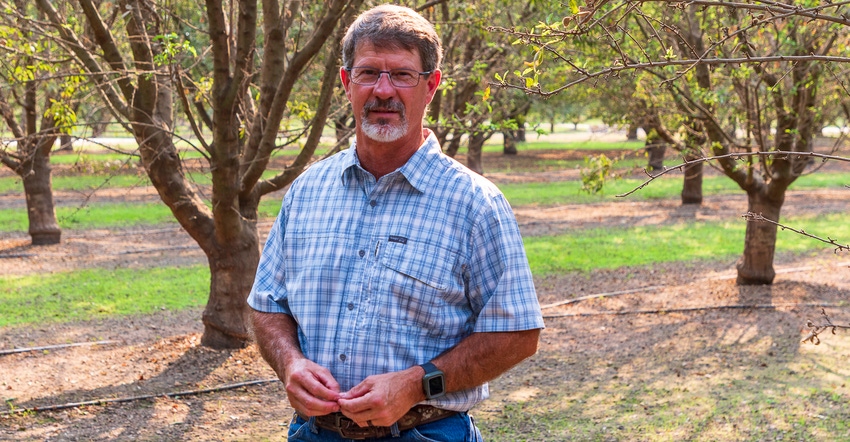
Hughson, Calif. almond grower Donny Hicks was worried ahead of harvest that lower nut prices would not adequately cover his fertilizer bill. Meetings with his processor suggested it would be close.
All that changed when his weight tags came in and he learned that his eighth leaf Independence trees produced over 4,000 pounds per acre.
"It looks like you can pay your fertilizer bill now," Hicks was told by his processor after sharing those concerns with him.
Hicks is a field representative with Olam Edible Nut's Hughson Nut company near Modesto, Calif. He laughs over the internal conversations he had with staff and executives, knowing in hindsight that his high yield would sufficiently cover his fertilizer program.
"Can I have more of that?" he joked with his PCA.
It wasn't just Hicks' fertilizer program that pushed his almond yield past 4,000 pounds per acre this season, but it helped.
Hicks' young Independence orchard is building a track record of good production when other issues are addressed. Two years ago he was challenged with bacterial blast in his trees. Coupled with the age of the trees this kept production to 2,300 pounds per acre when he thought he was on target for 3,000 pounds. The following year the trees produced 3,700 pounds. They surprised him further this year with just over 4,000 pounds on average.
Good fertilizer program
He credits part of this success to a good fertilizer program that his PCA oversees.
Patrick Machado, a pest control advisor with Mid Valley Agricultural Services in Oakdale, Calif. says good production is aided by feeding the trees right.
"If you can keep them fat and happy, they'll just keep producing," Machado says.
Machado delivers a proprietary blend of fertilizers in Hicks' drip irrigation system.
"It goes right to the root zone where you need it," he said.
Machado admits that along with micronutrients, nitrogen, phosphorous, potash, and humic acid were part of the program.
Machado points to potash, expensive as it became, as one of the key ingredients to a successful harvest.
"The UC system here in California has done great work to realize that we need 90 pounds per 1,000 pounds of meats, and if you don't replace that as the crop leaves your field every year you just start a downward trend," he said. "You're not only feeding your tree, it's also part of the soil structure."
Machado says for that reason, growers should stay on top of nutritional needs in their orchards, understanding closely what the trees produced, and working to replace those needs ahead of the following season.
"You've got to stay in front of those needs," Hicks continued.
Hicks is one of those farmers who plans well and is taking advantage of local nursery breeding programs that are developing solid trees. His well-managed orchard also benefits from stable water access through wells and surface water deliveries from a water district with ample supplies and water rights dating back to the 19th Century.
His trees show the attention to detail. Part of his young Independence block resembles a Nonpareil orchard for its tree size.
No bees?
Hicks grows Independence and Shasta trees. They're all planted on Viking rootstock, a complex hybrid of peach, almond, plum and apricot that Roger Duncan, a farm advisor with the University of California Cooperative Extension in Stanislaus County, says offers the benefits of Nemaguard rootstock without some of its weaknesses.
The bigger story, according to Hicks, is that the trees – billed as "self-fertile" by their respective nurseries – are said to succeed with fewer bees for pollination. Last season Hicks tried his luck and did not rent any bees. The success was seen in his deliveries to the processor.
Typically Hicks rents marginal bee colonies – those with fewer frame counts and smaller bee numbers – at a discount price. This is a benefit of a wife who works for a bee broker. In return the beekeepers tend to get hives back bubbling over with bees and new brood as almonds are said to be a "complete" nutritional resource for managed bee colonies. This was the first year he tried his luck with no bees because the weaker colonies he typically rented were unavailable.
"Normally I get the leftover bees, but this year they ran out of them," he said.
Research supplied by the Almond Board of California suggests that the self-fertile almond varieties still need bees to succeed. One such study of the Independence trees conducted in Kings County, Calif., suggests fruit set can be 60% higher in trees pollinated by honeybees, which translated in the study to a 20% increase in kernel yield.
Chances are that bees from neighboring almond orchards were involved in Hicks' success. Given the proximity to other orchards and bee colonies, this is likely. A nearby grower who also has Independence trees said he tends to use one colony per acre in his orchard, knowing well that some of his neighbors with the same variety do not rent bees and therefore may benefit from his bees.
About the Author(s)
You May Also Like






